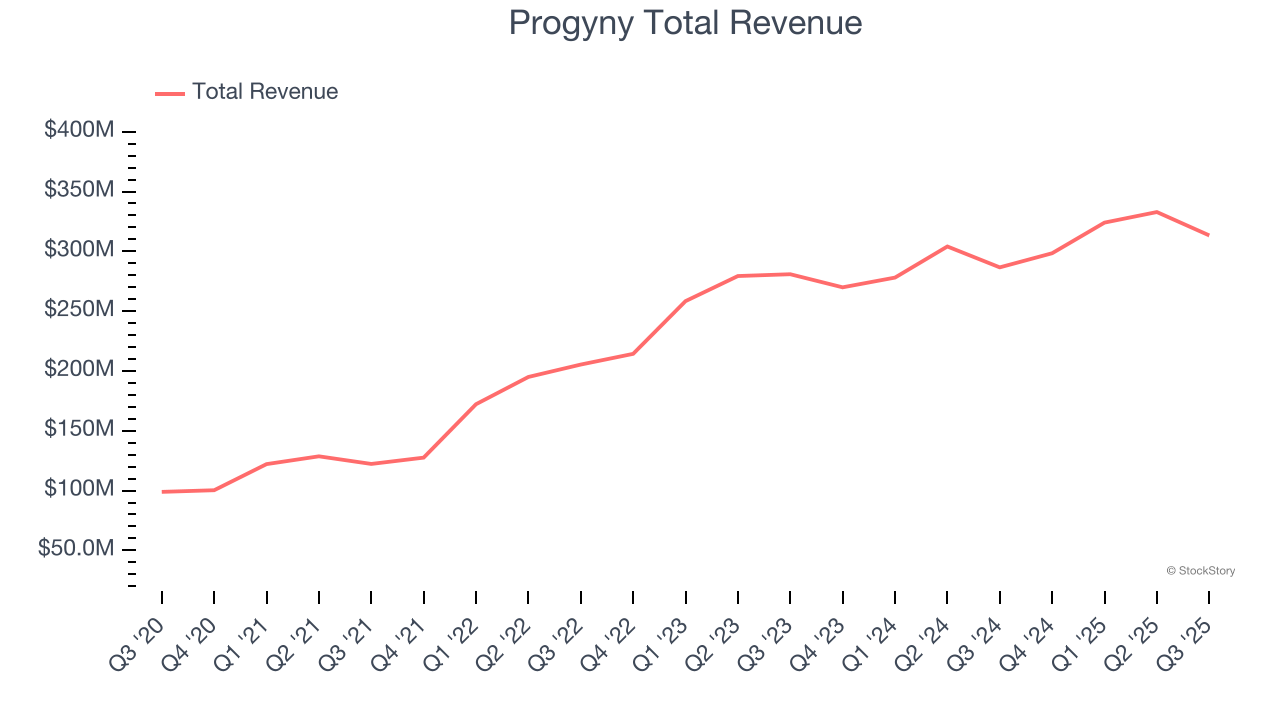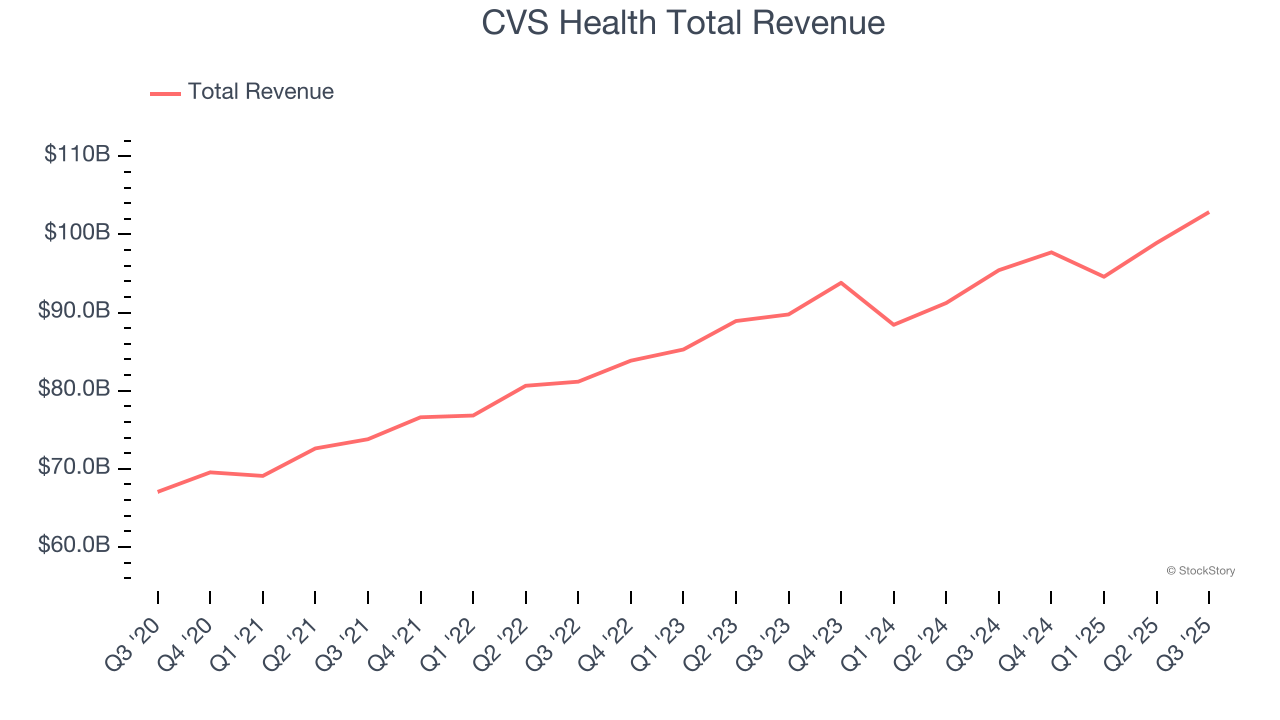
Let’s dig into the relative performance of Progyny (NASDAQ: PGNY) and its peers as we unravel the now-completed Q3 health insurance providers earnings season.
Upfront premiums collected by health insurers lead to reliable revenue, but profitability ultimately depends on accurate risk assessments and the ability to control medical costs. Health insurers are also highly sensitive to regulatory changes and economic conditions such as unemployment. Going forward, the industry faces tailwinds from an aging population, increasing demand for personalized healthcare services, and advancements in data analytics to improve cost management. However, continued regulatory scrutiny on pricing practices, the potential for government-led reforms such as expanded public healthcare options, and inflation in medical costs could add volatility to margins. One big debate among investors is the long-term impact of AI and whether it will help underwriting, fraud detection, and claims processing or whether it may wade into ethical grey areas like reinforcing biases and widening disparities in medical care.
The 12 health insurance providers stocks we track reported a strong Q3. As a group, revenues beat analysts’ consensus estimates by 2.4% while next quarter’s revenue guidance was 1.1% below.
Amidst this news, share prices of the companies have had a rough stretch. On average, they are down 5.7% since the latest earnings results.
Progyny (NASDAQ: PGNY)
Pioneering a data-driven approach to family building that has achieved an industry-leading patient satisfaction score of +80, Progyny (NASDAQ: PGNY) provides comprehensive fertility and family building benefits solutions to employers, helping employees access quality fertility treatments and support services.
Progyny reported revenues of $313.3 million, up 9.3% year on year. This print exceeded analysts’ expectations by 4.7%. Overall, it was a very strong quarter for the company with an impressive beat of analysts’ revenue estimates and a solid beat of analysts’ full-year EPS guidance estimates.
“Our strong results this quarter reflect that members have continued to pursue the care and services they need in order to best address both their family building goals and their overall health, and did so at levels that exceeded our expectations,” said Pete Anevski, Chief Executive Officer of Progyny.

Interestingly, the stock is up 48.8% since reporting and currently trades at $26.80.
Is now the time to buy Progyny? Access our full analysis of the earnings results here, it’s free for active Edge members.
Best Q3: CVS Health (NYSE: CVS)
With over 9,000 retail pharmacy locations serving as neighborhood health destinations across America, CVS Health (NYSE: CVS) operates retail pharmacies, provides pharmacy benefit management services, and offers health insurance through its Aetna subsidiary.
CVS Health reported revenues of $102.9 billion, up 7.8% year on year, outperforming analysts’ expectations by 4.1%. The business had an exceptional quarter with an impressive beat of analysts’ same-store sales estimates and a solid beat of analysts’ revenue estimates.

Although it had a fine quarter compared its peers, the market seems unhappy with the results as the stock is down 4.8% since reporting. It currently trades at $78.23.
Is now the time to buy CVS Health? Access our full analysis of the earnings results here, it’s free for active Edge members.
Weakest Q3: Molina Healthcare (NYSE: MOH)
Founded in 1980 as a provider for underserved communities in Southern California, Molina Healthcare (NYSE: MOH) provides managed healthcare services primarily to low-income individuals through Medicaid, Medicare, and Marketplace insurance programs across 21 states.
Molina Healthcare reported revenues of $11.48 billion, up 11% year on year, exceeding analysts’ expectations by 4.7%. Still, it was a slower quarter as it posted a significant miss of analysts’ full-year EPS guidance estimates and a significant miss of analysts’ EPS guidance for next quarter estimates.
As expected, the stock is down 29.4% since the results and currently trades at $137.44.
Read our full analysis of Molina Healthcare’s results here.
Elevance Health (NYSE: ELV)
Formerly known as Anthem until its 2022 rebranding, Elevance Health (NYSE: ELV) is one of America's largest health insurers, serving approximately 47 million medical members through its network-based managed care plans.
Elevance Health reported revenues of $50.71 billion, up 12.4% year on year. This print surpassed analysts’ expectations by 1.5%. It was a strong quarter as it also logged a beat of analysts’ EPS estimates and a narrow beat of analysts’ revenue estimates.
The company lost 252,000 customers and ended up with a total of 45.37 million. The stock is down 6.2% since reporting and currently trades at $332.13.
Read our full, actionable report on Elevance Health here, it’s free for active Edge members.
Alignment Healthcare (NASDAQ: ALHC)
Founded in 2013 with a mission to transform healthcare for seniors, Alignment Healthcare (NASDAQ: ALHC) provides Medicare Advantage health plans for seniors with features like concierge services, transportation benefits, and technology-driven care coordination.
Alignment Healthcare reported revenues of $993.7 million, up 43.5% year on year. This result topped analysts’ expectations by 1.2%. Overall, it was a strong quarter as it also recorded a beat of analysts’ EPS estimates and full-year EBITDA guidance exceeding analysts’ expectations.
The company added 5,900 customers to reach a total of 229,600. The stock is down 5.3% since reporting and currently trades at $16.22.
Read our full, actionable report on Alignment Healthcare here, it’s free for active Edge members.
Market Update
Thanks to the Fed’s rate hikes in 2022 and 2023, inflation has been on a steady path downward, easing back toward that 2% sweet spot. Fortunately (miraculously to some), all this tightening didn’t send the economy tumbling into a recession, so here we are, cautiously celebrating a soft landing. The cherry on top? Recent rate cuts (half a point in September 2024, a quarter in November) have propped up markets, especially after Trump’s November win lit a fire under major indices and sent them to all-time highs. However, there’s still plenty to ponder — tariffs, corporate tax cuts, and what 2025 might hold for the economy.
Want to invest in winners with rock-solid fundamentals? Check out our Hidden Gem Stocks and add them to your watchlist. These companies are poised for growth regardless of the political or macroeconomic climate.
StockStory’s analyst team — all seasoned professional investors — uses quantitative analysis and automation to deliver market-beating insights faster and with higher quality.








